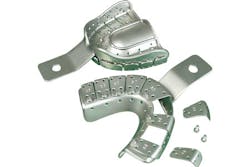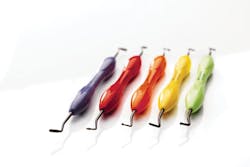Pearls for Your Practice: Implant impression trays, wound protecting device, restorative instruments
WindowTray implant impression trays by PDT
When I opened my practice about eight years ago, I had to order all my instruments and setups. I had been introduced to Paradise Dental Technologies (PDT) hygiene instruments and really liked them in a practice that I had worked in as an associate. As a young dentist starting my own practice, it was more economically viable for me to do my own hygiene at first. When it was time to order my hygiene instruments, I knew I was going with PDT. There was one PDT instrument I fell in love with that became my go-to instrument: the Montana Jack. It is the perfect scaler. Now, my hygienists love it too. In fact, I still keep a PDT Montana Jack scaler in my crown-insert kits.
Recently, I found out that PDT makes more than just hygiene instruments, and I had to try some of the surgical, restorative, and implant offerings.
One of PDT’s implant offerings is the WindowTray, which is particularly well thought-out and designed. Open-tray implant impressions can be complex procedures that take some thought and planning. Most prosthodontists agree that open-tray impressions are more stable and accurate than closed-tray impressions. Taking an open-tray impression requires either fabricating a custom tray or grinding a hole in a plastic tray for the coping to stick through. Either way, time and costs are sunk into it. With PDT’s WindowTray, a quick flick of a screwdriver gives you a nice metal impression tray with a window in the perfect spot for your implant impression.
The WindowTray has nine different removable segments that allow you to customize the tray for the exact situation you have at hand. The removable segments are screw-retained, and they’re quick and easy to remove and put back on. The WindowTray comes in three sizes - small, medium, and large—for both the maxillary and mandibular arches. Each tray runs around $200, so I started with one medium upper tray and one medium lower tray. I will add other sizes and arches as I need them. Using the WindowTray has kept me from needing to order or make a custom tray a couple of times now. That has helped to offset the cost. I also like that the WindowTray is made of rigid metal, which is always better for impressions than a plastic tray with an awkward hole cut in it.
PDT makes quality instruments, and it’s a family-owned company that stands behind its products with a great warranty. Knowing my investments are protected is the reason I have so many PDT instruments on my tray. The WindowTray is a really nice instrument to have on hand for implant restorations. Having what amounts to a quick and easy custom tray for implant impressions is very convenient. Opposite-field double for PDT’s WindowTray!
Mouth-Mate wound-protecting device by Armor Dental
As clinicians, we know that plaque is the source of so many of our patients’ problems. Despite this, we often end up performing procedures on our patients that prevent them from adequately debriding plaque, especially during the healing phase. We know that if our patients could better control plaque around surgical sites, those sites would heal better and faster.
Mouth-Mate by Armor Dental is an adjunctive device that can help your patients control plaque around surgical sites without pain or discomfort. It acts as a physical barrier to prevent surgical sites or sores from being disturbed during tooth brushing. With a Mouth-Mate, the surgical site is protected while the patient brushes adjacent teeth. Without protection, many patients probably skip the area entirely and let plaque build on adjacent teeth.
Patients hold the Mouth-Mate with one hand and brush with the other. Most patients find this to be no problem, and some in-office studies have demonstrated that patients think it is easy to use.
There are four different designs that you may select for your patients. The circular Mouth-Mate is great for patients who have sores and for those who have undergone third-molar extractions, frenectomies, apicoectomies, or lip surgeries. The oval-shaped Mouth-Mate is ideal for patients with aphthous ulcers and for patients who have had periodontal surgeries—such as connective tissue grafts, crown lengthening, or osseous surgery—or biopsies. The last two designs are U-shaped. The small U-shaped design is ideal for patients who have had extractions or implants from the premolars forward. The large U-shaped design is excellent for molar extraction sites and implants.
The Mouth-Mate can be a giveaway for patients who have had certain types of procedures. The cost—about $5 each—must be absorbed somehow. If you are a fee-for-service practice, it’s easy: raise the fee by $5 to cover the costs. If you are a PPO practice locked into a lower reimbursement, I think it is reasonable to charge the patient an additional fee for a Mouth-Mate. If the dentist, the surgeon, or a staff member reviews the advantages of maintaining good plaque control during healing, the value should be clear to the patient, and the $5 fee should be of little consequence.
Mouth-Mate offers a solution for a problem we tend to see with our patients. If we can help them maintain good oral hygiene during the healing phase, we can promote healthy outcomes. Single back up the middle for Mouth-Mate!
LM Dental ErgoSense Dark Diamond restorative instruments
According to the American Dental Association, more than 230 million restorations are placed annually in the United States. (1) Of those, 75% are direct restorations. (1) That means that we are shaping and contouring composite over and over, all day long. That’s a shame. Resin composite restorations, in my opinion, are the most problematic and difficult restorations we do in dentistry. Having quality instruments for direct restoration placement is important in making difficult procedures just a little bit easier. LM Dental ErgoSense Dark Diamond restorative instruments have become some of my go-to instruments.
The first thing you’ll notice about the ErgoSense instruments are the bright, colorful, and ergonomic silicon handles. But the handle is more than just a splash of color. It is specifically designed for superior ergonomics. The next thing you’ll notice is how great it feels to hold in your hand. It is the perfect size and width and has a bit of softness to it that makes it comfortable to hold for a long time. For larger clinics or practices, RFID technology can be integrated into the instrument handles for a precise, robust instrument tracking system.
My first concern was how well these handles would hold up to autoclaving. In my practice, they have held up perfectly over about a hundred cycles. The manufacturer has tested them over thousands and thousands of cycles with zero issues.
Available in a large assortment of shapes and sizes, there are plenty of LM ErgoSense choices to fill your armamentarium. The LM ErgoSense Sharp Diamond hygiene and perio instruments promise “sharpen-free perio.” The tips are coated with a micromembrane using physical vapor deposition, so they have a long-lasting sharpness that will make your hygienists happy.
Since trying the Dark Diamond instruments, I have replaced all my old house-brand restorative instruments. Resin composite does not stick to the ErgoSense instruments, so they are a real joy to use.
Another benefit has been how easy it is for my assistants to locate particular instruments. Since all the handles are different colors, I can ask for “the yellow one” instead of a PKT 1, for instance. My assistant can track it down more quickly than with our previous setups, in which all the handles looked exactly the same.
Hard-hit single to left field for LM ErgoSense Dark Diamond instruments!
Reference
1. American Dental Association. 2005-06 Survey of Dental Services Rendered. Chicago, IL: American Dental Association Survey Center; 2007.
About the Author
Joshua Austin, DDS, MAGD
Joshua Austin, DDS, MAGD, is a graduate and former faculty member of the University of Texas Health Science Center at San Antonio School of Dentistry. Author of Dental Economics’ Pearls for Your Practice column, Dr. Austin lectures nationally on products, dental technology, online reputation management, and social media. He maintains a full-time restorative dentistry private practice in San Antonio, Texas. You may contact Dr. Austin at [email protected].
Updated June 21, 2023




